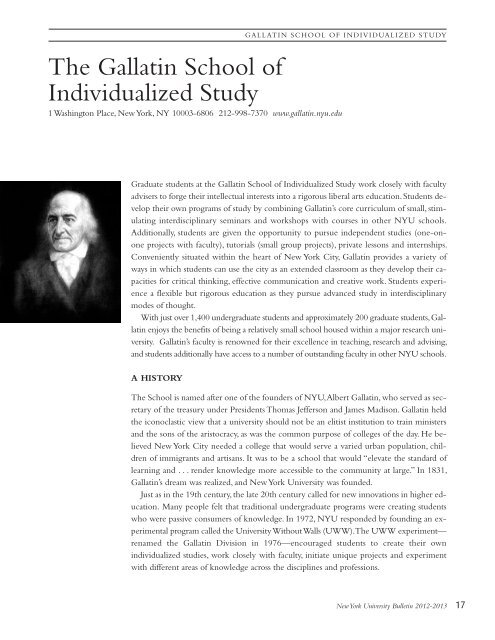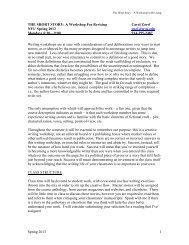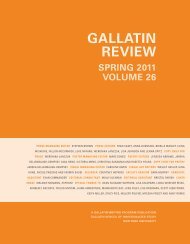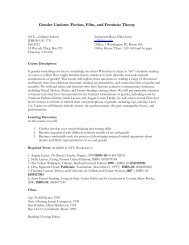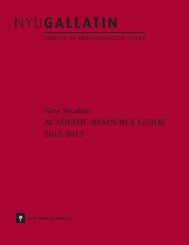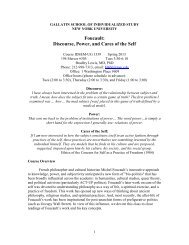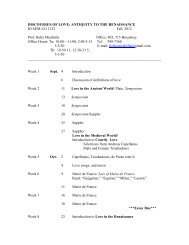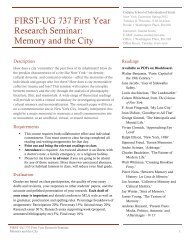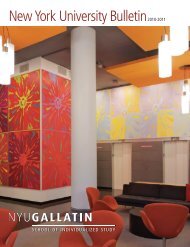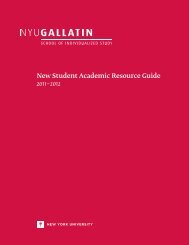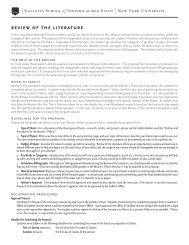New York University Bulletin - Gallatin School of Individualized ...
New York University Bulletin - Gallatin School of Individualized ...
New York University Bulletin - Gallatin School of Individualized ...
Create successful ePaper yourself
Turn your PDF publications into a flip-book with our unique Google optimized e-Paper software.
The <strong>Gallatin</strong> <strong>School</strong> <strong>of</strong><strong>Individualized</strong> Study1 Washington Place, <strong>New</strong><strong>York</strong>, NY 10003-6806 212-998-7370 www.gallatin.nyu.eduGALLATIN SCHOOL OF INDIVIDUALIZED STUDYGraduate students at the <strong>Gallatin</strong> <strong>School</strong> <strong>of</strong> <strong>Individualized</strong> Study work closely with facultyadvisers to forge their intellectual interests into a rigorous liberal arts education. Students developtheir own programs <strong>of</strong> study by combining <strong>Gallatin</strong>’s core curriculum <strong>of</strong> small, stimulatinginterdisciplinary seminars and workshops with courses in other NYU schools.Additionally, students are given the opportunity to pursue independent studies (one-ononeprojects with faculty), tutorials (small group projects), private lessons and internships.Conveniently situated within the heart <strong>of</strong> <strong>New</strong> <strong>York</strong> City, <strong>Gallatin</strong> provides a variety <strong>of</strong>ways in which students can use the city as an extended classroom as they develop their capacitiesfor critical thinking, effective communication and creative work. Students experiencea flexible but rigorous education as they pursue advanced study in interdisciplinarymodes <strong>of</strong> thought.With just over 1,400 undergraduate students and approximately 200 graduate students,<strong>Gallatin</strong>enjoys the benefits <strong>of</strong> being a relatively small school housed within a major research university.<strong>Gallatin</strong>’s faculty is renowned for their excellence in teaching, research and advising,and students additionally have access to a number <strong>of</strong> outstanding faculty in other NYU schools.A HISTORYThe <strong>School</strong> is named after one <strong>of</strong> the founders <strong>of</strong> NYU,Albert <strong>Gallatin</strong>, who served as secretary<strong>of</strong> the treasury under Presidents Thomas Jefferson and James Madison. <strong>Gallatin</strong> heldthe iconoclastic view that a university should not be an elitist institution to train ministersand the sons <strong>of</strong> the aristocracy, as was the common purpose <strong>of</strong> colleges <strong>of</strong> the day. He believed<strong>New</strong> <strong>York</strong> City needed a college that would serve a varied urban population, children<strong>of</strong> immigrants and artisans. It was to be a school that would “elevate the standard <strong>of</strong>learning and . . . render knowledge more accessible to the community at large.” In 1831,<strong>Gallatin</strong>’s dream was realized, and <strong>New</strong><strong>York</strong> <strong>University</strong> was founded.Just as in the 19th century, the late 20th century called for new innovations in higher education.Many people felt that traditional undergraduate programs were creating studentswho were passive consumers <strong>of</strong> knowledge. In 1972, NYU responded by founding an experimentalprogram called the <strong>University</strong>WithoutWalls (UWW).The UWW experiment—renamed the <strong>Gallatin</strong> Division in 1976—encouraged students to create their ownindividualized studies, work closely with faculty, initiate unique projects and experimentwith different areas <strong>of</strong> knowledge across the disciplines and pr<strong>of</strong>essions.<strong>New</strong><strong>York</strong> <strong>University</strong> <strong>Bulletin</strong> 2012-2013 17


